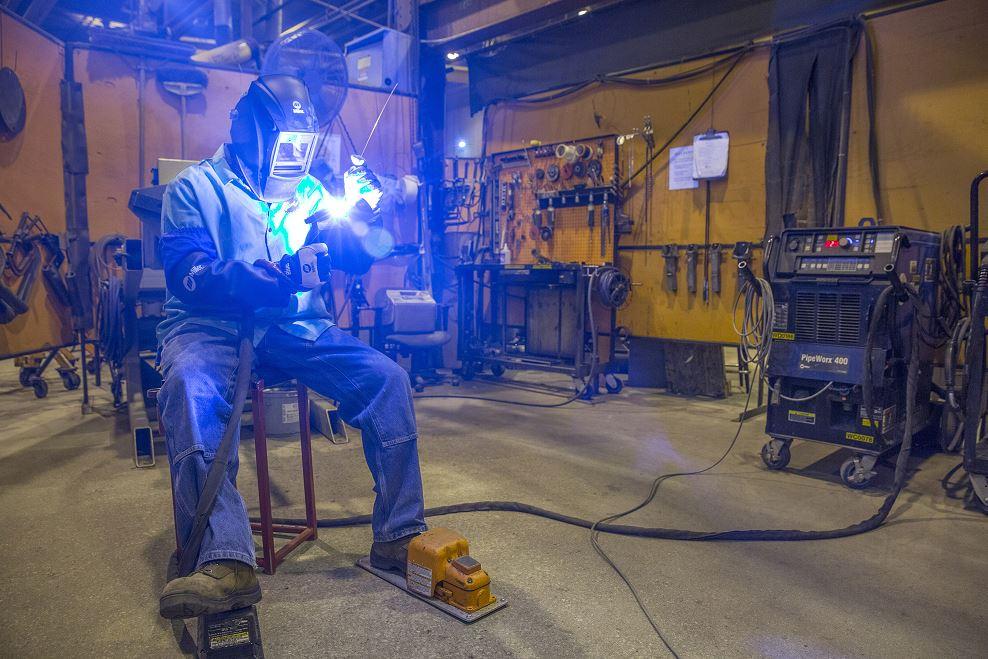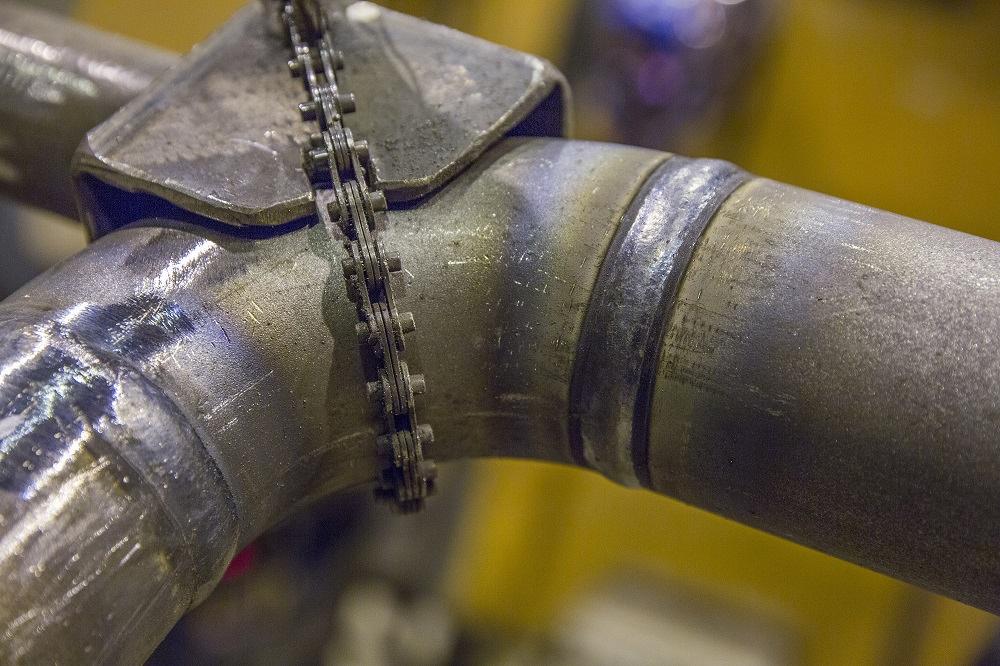Business Development Manager
- FMA
- The Fabricator
- FABTECH
- Canadian Metalworking
Categories
- Additive Manufacturing
- Aluminum Welding
- Arc Welding
- Assembly and Joining
- Automation and Robotics
- Bending and Forming
- Consumables
- Cutting and Weld Prep
- Electric Vehicles
- En Español
- Finishing
- Hydroforming
- Laser Cutting
- Laser Welding
- Machining
- Manufacturing Software
- Materials Handling
- Metals/Materials
- Oxyfuel Cutting
- Plasma Cutting
- Power Tools
- Punching and Other Holemaking
- Roll Forming
- Safety
- Sawing
- Shearing
- Shop Management
- Testing and Measuring
- Tube and Pipe Fabrication
- Tube and Pipe Production
- Waterjet Cutting
Industry Directory
Webcasts
Podcasts
FAB 40
Advertise
Subscribe
Account Login
Search
Saving time and money with a new pipe welding process
RMD helps shop meet an otherwise insurmountable deadline
- By Danny Mortensen
- March 20, 2024
- Article
- Tube and Pipe Fabrication
Bidding on a customer job is just par for the course for one Oklahoma-based compression skid manufacturer serving midstream oil and gas operations. When a bid is accepted, it’s a great day for the shop. But when bid details change, the manufacturer needs to switch gears and course-correct—and fast.
In this case, the manufacturer had painstakingly priced out each unit and submitted a comprehensive bid for the job. The order was for an international compressor station, so the deadlines factored into the quote had to incorporate shipping time across the ocean. When the final bid package came through, the manufacturer received a new set of procedures from the customer, which was going to have major implications for the shop’s operations and bottom line.
TIG Needed?
Conventional wisdom said that the customer’s procedures required TIG welding on all welding joints that couldn’t be back gouged. In addition, a significant portion of the job’s welds were on pipe too small to access for gouging, which meant that the shop would have to use TIG welding to complete a lot of the work.
The sticking point was that the original bid did not factor in TIG welding, making the new requirements difficult to accommodate without sacrificing time, money, and quality of work.
For this project, TIG welding would easily increase the 40 hours quoted per unit to 100 hours because of the slower nature of the process. Additionally, the higher skillset TIG requires left the shop without qualified welders to get the job done. Finding enough qualified employees was already hard to do in a region experiencing a welder shortage, but finding enough people skilled in TIG added another layer to the challenge.
On top of that, the shop was now operating under a real time crunch. Once the new requirements were issued, it had to ship its first skid of parts in 12 weeks.
RMD Eliminates Steps
The manufacturer was using two machines in each bay. Welders had to unplug one machine so they could plug in the other to run their cap passes—a cumbersome process.
The team needed a solution and had two options: TIG welding or something else. Fortunately, something else existed.
The company consulted its welding distributor, which then reached out to Miller Electric. The recommendation from Miller was to use regulated metal deposition for open root welding, a process that the manufacturer’s customer had already approved for other projects.
RMD is a modified short-circuit welding process designed specifically for open root and gauged material welding. The modified wave form is designed to fill gaps in thin-material applications and execute root passes with a stable arc and minimal spatter. It has been documented to provide double or triple the travel speed of other process options.
In addition, RMD can potentially eliminate hot passes. Typically, TIG creates root passes that are 1/8 to 3/16 in. thick, which then typically require a hot pass before moving on to a high-deposition, pulsed MIG pass. RMD creates a thicker root pass (typically 3/16 in. or greater) and is thick enough to go straight into a pulsed fill and cap pass. It’s also tolerant of differences in operator technique and contact tip to work distance, maintaining a consistent arc length and bead profile.
Using a Multiprocess System
The manufacturer also looked into Miller’s PipeWorx multiprocess welding system, which is designed exclusively for pipe fabrication shops. Follow-up conversations confirmed that this would be a viable solution that would make it possible for the operation to meet the customer’s new requirement. The manufacturer installed a PipeWorx 400 to give its welders the opportunity to try the machine and hear their thoughts on whether the technology would be beneficial for their day-to-day operations.
The response was positive. The machine’s dual feeder helped streamline the shop’s work process and minimize the machine footprint in the welding booths. Additionally, the shop found that the machine’s arc characteristics and ease of weldability were better than the equipment it had been using.
Developed for Pipe Welders by Pipe Welders
The needs of pipe fabrication shops and the welders doing the work are unique to this industry. The architecture of the gun, the filler metal to bridge gaps, and arcs that give good results are key to manipulating the puddle or completing a weld joint. That’s why pipe welders were consulted to help design this system, which is made exclusively for process piping, refinery, petrochemical, power, HVAC, and water pipe fabrication.
The system offers several distinctive characteristics:
- Multiprocess machine - It includes conventional stick, DC TIG, MIG, flux-cored, advanced RMD, and pulsed MIG processes. The weld processes are built to deliver excellent arc performance and stability specifically for root pass, fill, and cap pipe welding.
- Simple process setup - Only a few basic steps are required to set up a new weld process, minimizing training time and errors from incorrect setups. The memory function stores four programs for each process selection, which can be beneficial when using multiple procedures, process parameters, or welders.
- Quick process changeover - After the user chooses the welding process, the Quick-Select function automatically selects the correct polarity, cable outputs, and welding parameters. It also eliminates the setup time for switching cables and gas hoses and reduces the risk of weld reworks because of incorrect cable connections.
Since implementing the new machine and method, the manufacturer’s pass rate jumped from 70% to 92%, eliminating huge expenses and the time spent reworking welds. Not only was the manufacturer able to honor its contract, it gained valuable efficiencies and turned out a better product in the process.
About the Author
About the Publication
Related Companies
subscribe now

The Tube and Pipe Journal became the first magazine dedicated to serving the metal tube and pipe industry in 1990. Today, it remains the only North American publication devoted to this industry, and it has become the most trusted source of information for tube and pipe professionals.
start your free subscription- Stay connected from anywhere

Easily access valuable industry resources now with full access to the digital edition of The Fabricator.

Easily access valuable industry resources now with full access to the digital edition of The Welder.

Easily access valuable industry resources now with full access to the digital edition of The Tube and Pipe Journal.
- Podcasting
- Podcast:
- The Fabricator Podcast
- Published:
- 04/16/2024
- Running Time:
- 63:29
In this episode of The Fabricator Podcast, Caleb Chamberlain, co-founder and CEO of OSH Cut, discusses his company’s...
- Trending Articles
Zekelman Industries to invest $120 million in Arkansas expansion

3D laser tube cutting system available in 3, 4, or 5 kW

Corrosion-inhibiting coating can be peeled off after use

Brushless copper tubing cutter adjusts to ODs up to 2-1/8 in.

HGG Profiling Equipment names area sales manager

- Industry Events
16th Annual Safety Conference
- April 30 - May 1, 2024
- Elgin,
Pipe and Tube Conference
- May 21 - 22, 2024
- Omaha, NE
World-Class Roll Forming Workshop
- June 5 - 6, 2024
- Louisville, KY
Advanced Laser Application Workshop
- June 25 - 27, 2024
- Novi, MI





























